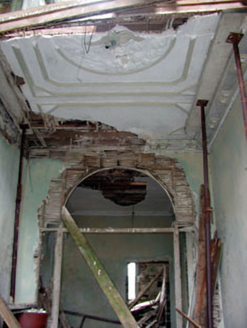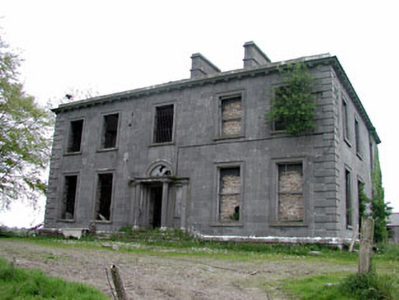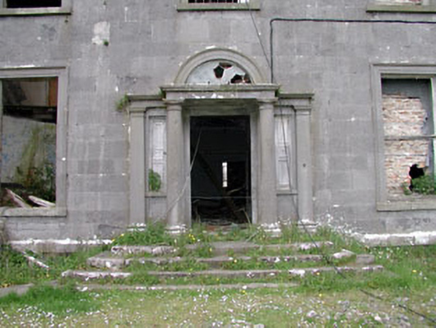Survey Data
Reg No
14305026
Rating
Regional
Categories of Special Interest
Social
Original Use
Country house
Date
1815 - 1820
Coordinates
253743, 279137
Date Recorded
13/05/2002
Date Updated
--/--/--
Description
Detached five-bay (three-bay deep) two-storey over basement country house, built 1817, on a rectangular plan. Occupied, 1901; 1911. Sold, 1926. Now disused. Remains of hipped slate roof behind parapet with paired limestone ashlar central chimney stacks on cut-limestone cushion courses on limestone ashlar bases having cut-limestone stringcourses below capping, and concealed rainwater goods. Limestone ashlar walls on lichen-covered cut-limestone chamfered cushion course on plinth with rusticated cut-limestone quoins to corners supporting dentilated ogee-detailed cornice below parapet. Segmental-headed central door opening in tripartite arrangement approached by flight of four cut-limestone steps, cut-limestone doorcase with Doric columns on plinths having responsive pilasters supporting ogee-detailed cornice on blind frieze, and cut-limestone archivolt framing remains of timber door having fanlight with remains of timber sidelights. Square-headed window openings with cut-limestone sills, and cut-limestone surrounds framing remains of one-over-one timber sash windows. Interior in ruins including (ground floor): central hall with egg-and-dart-detailed decorative plasterwork cornice to compartmentalised ceiling centred on decorative plasterwork medallion. Set in unkempt grounds.
Appraisal
A country house erected by George Rotheram (1761-1821) representing an important component of the domestic built heritage of County Meath with the architectural value of the composition confirmed by such attributes as the compact rectilinear plan form centred on a Classically-detailed doorcase showing a pretty cobweb fanlight; the construction in a tooled silver-grey limestone demonstrating good quality workmanship; the diminishing in scale of the openings on each floor producing a graduated visual impression; and the parapeted roof. Although reduced to near ruins following a prolonged period of neglect in the later twentieth century, the form and massing survive intact together with quantities of the original fabric, both to the exterior and to the interior where decorative plasterwork in the style of Michael Stapleton (c.1747-1801) of Dublin (Mulligan 2001, 171) highlights the artistic potential of the composition. Furthermore, adjacent outbuildings (see 14305027 - 14305036); and a walled garden (see 14305028), all continue to contribute positively to the group and setting values of an increasingly forlorn estate having historic connections with the Rotheram family including Edward Rotheram JP (1789-1881) and Barbara Rotheram (née Crofton) (1799-1863) 'late of Crossdrum Oldcastle County Meath' (Calendars of Wills and Administrations 1863, 169; 1881, 594); Edward Rotheram JP (1828-1904) and Maria Louisa Rotheram (née Cooper) (1837-1919) 'late of Crossdrum Oldcastle County Meath' (Calendars of Wills and Administrations 1904, 437); Edward Rotheram (1872-1925) and Jane Mabel Rotheram (née Gardner) (1887-1943); and Edward Rotheram (1908-1968) who sold Crossdrum House (1926). NOTE: Amongst the surviving plasterwork is the impaled coat of arms bearing the three stags of Edward Rotheram and the lion rampant of Barbara Crofton with the motto "Honor et Honestas" [Honour and Honesty].





